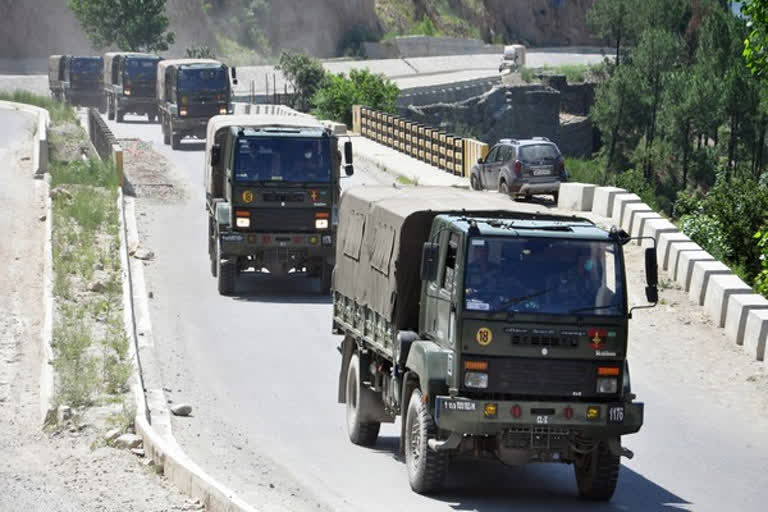New Delhi: Forlorn and devoid of vegetation, the cold deserts of eastern Ladakh may seem forbidding for many. But it is here that one of the biggest face-offs with crucial stakes in global geo-politics is being waged.
With the Indian and Chinese military buildup and mobilization showing no signs of abating and with both countries sticking to their respective stands, there is a dawning realisation that the conflict may indeed get only more intense in the near future.
Both India and China have dug their heels in and are readying for the harsh winter which will set in another two months in the border areas. Accordingly, high-altitude winter equipment is being procured for the Indian army besides military equipment.
“Operational deficiencies in terms of weapons, ammunition and equipment like sensors have been identified. Our emergency military procurement under the Indian army’s vice-chief’s watch has multiplied. We are buying more weapons, ammunition and sensors,” a serving military official familiar with the details told ETV Bharat.
“In the past, there would be 12-15 contracts every year. After the border incidents with China, about 100 military deals have been contracted that are likely to be completed by the end of this financial year,” the official added.
According to another source, the defence secretary (production) is also expected to visit Russia in a couple of days for the “Army-2020” which is a Russian military expo where military hardware is showcased for striking commercial deals. Military equipment including a long-standing deal for joint production of AK-203 assault rifles is also likely to fructify.
The hunt for top quality military equipment has become more urgent particularly because of the prevailing belief that all future wars will be ‘intense’ and ‘short’. The Joint Indian Armed Forces Doctrine (2017) declares: “The character of future wars is likely to be ambiguous, uncertain, short, swift, lethal, intense, precise, non-linear, unrestricted and hybrid.”
Prevalent Mindset
What makes the ongoing conflict very different and with the deadly potential to escalate this time is the prevalent mindset of the leadership of the two countries whose diktat the militaries have to follow.
At the moment, both the Asian giants are witnessing the dominance of a very strong nationalist ideology. Without doubt, nationalism has been a key ideological plank for both Indian PM Narendra Modi and Chinese President Xi Jinping.
While India is looking for a place under the sun as a global force, China’s ambitious bid to be a top nation by 2049 has to overcome the existent challenge posed by the US which is equally determined not to forgo its position as the world’s most powerful nation. A conflict and its result will therefore determine the future course of world politics.
An all-out conflict has implications for the US too as President Donald Trump faces an uncertain election in November. He would not let an opportunity to improve his chances go by.
Failure of Mechanisms
India and China have a slew of mechanisms that are geared to prevent the outbreak of hostilities. They are at the military level, the diplomatic level, at the level of special representatives (or the NSA level in the Indian case), not to speak of the “informal” summits between PM Modi and President Xi.
But in the present context, other than the Modi-Xi mechanism right at the top, there is reason to believe that all the other mechanisms have been tried, tested, and they have failed. The resolution process lies in a deadlock.
COVID Pandemic
While both India and China have revealed weaknesses in their fight against the novel coronavirus, the pandemic has underlined and exposed US’ vulnerabilities as New York became the Ground Zero with the most numbers of deaths.
An all-out India-China conflict would serve to divert public attention from the establishment’s handling of the pandemic and consolidate the main support base. But it will also accord China a chance to take aim at the US when it is at its weakest, wracked as it is also by the racial riots.
For India, with a GDP at one-third of China’s and already staring as an underdog, a forced pull-back by China will establish its long-sought place as a global power in the world comity of nations. And that is why both countries won’t back down from brinkmanship right up to the edge. There is already a US-led alliance that is egging India to “stare down” China.
Quad Implications
With an India-US-Japan-Australia ‘Quad’ formation shaping up on an anti-China plank, a favourable result for China in the conflict against India would demolish ‘Quad’ even before it had taken off. It would underline China’s position right at the top and cement it for quite some time to go. It is too much of an opportunity for China to let go.
In a nutshell, while Chinese designs are definitely aggressive, India is prepared not to yield. Therefore, from the Indian perspective, the only way out is for China to pull back. With a definite change in the Indian establishment’s mindset this time around, the conflict, therefore, has all chances of escalation.



